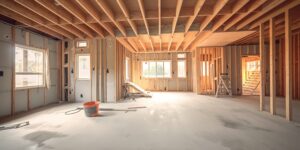Once upon a time, just having a website was enough to set a home builder apart from the competition. But that was before 97% of homebuyers started using the internet in their home search.1
Today, the playing field has changed, and the competition is heating up for home builders. For more than half of all buyers, searching online marks the first step toward purchasing a home. Google receives more than 13 billion real estate searches annually.2 Zillow.com, the most popular real estate site, receives nearly 264 million visits every month.3
In today’s complex, rapidly changing, digitally driven media environment, capturing a home shopper’s attention is more difficult—and important—than ever. People rank finding the right property as the most difficult step in home buying.4 For the companies that crack the code on leveraging a strong digital presence, the work pays off. Consider this:
- Buyers find the home they will purchase online 51% of the time.
- Real estate agents outrank mobile or tablet devices by just 5% as the most frequently used home search information source.
- The average home buyer requires 6-8 touches before making contact and about 52 total touch points to make a purchase.5
To convert potential buyers into viable sales leads, builders must ensure their website is fully optimized for the target audience—from content and design to functionality and features.
Content and Search Engine Optimization
More than 50% of home viewings are done solely online. For builders, organic search results contribute to more than half of online leads if the website is optimized for search engines.
To take full advantage of home buyers’ use of search engines to shop for homes, builders need to create robust content that is:
Optimized for Local Search
Most home shoppers begin their research using a local search term such as “Virginia new homes for sale,” “Condos in Chicago,” and “Houses for sale in Florida with a pool.” Properties ranking in Google’s top spot will earn more than 36% of all clicks. More than 75% of clicks go to just the top three results.6
The key to more views also can come from narrower searches. Showing up well in geographic-based results are important as buyers focus on what they’re really looking for and search at the neighborhood level instead of by city or region. To remain visible, builders need to optimize their websites for ultra-local search terms based on districts or sub-cities such as “Franklin Park real estate agent” instead of “Austin real estate agent.”
Useful and Easy to Comprehend
The oversaturation of online content has made search engines more selective about what ranks well. Overgeneralized content no longer serves a purpose. The more specific, niche-oriented, and useful your website is, the better the rankings it can achieve.
To be considered useful, your content needs to address what home buyers want. Builders can do this by providing the types of online tools home buyers rank as most useful, including:
- 89% photos
- 86% detailed property information
- 67% floor plans
- 58% virtual tours
- 57% customer reviews and testimonials
- 50% mortgage and financial calculators
- 50% information on the home buying and selling process
Interactive with a Visual Impact
The more online resources home buyers have at their disposal—and competing for their attention—the more important it becomes to provide content your audience will consume and enjoy, then act upon. Static content needs interactive tools to help it stand out and stay memorable.
“By its very nature, interactive content engages participants in an activity: answering questions, making choices, exploring scenarios,” says marketing expert Scott Brinker. “Individuals have to think and respond; they can’t just snooze through it.”
Video is one of the most popular forms of interactive content among home buyers, especially with 50% of buyers using mobile devices in their search. Prospective buyers, especially among older generations, use real estate videos as a source of home search information 41% of the time.
Videos pay big dividends when it comes to how sites show up in organic search results. In fact, embedded videos drive 157% more search results and get 403% more inquires than sites without them.7
House hunters primarily use video to:
- Learn more about the community
- Tour the inside of a home
- Obtain general information
- Understand and compare features across multiple properties
- Watch customer testimonials
- Educate themselves on homeownership and market conditions
Other helpful interactive tools include:
- Interactive floor plans allowing the buyer to tag on additions, subtract rooms, and more.
- Calculators that help home buyers answer financial questions and review options.
- Custom dashboards letting shoppers save their favorite floor plans as they navigate your site.
- Home buyer’s toolkits answering FAQs, providing structural home warranty information, and explaining what to expect from a new-home build.
- Share buttons making it easy for buyers to email you, share their favorite floor plan on social media, pin a photo, and like a blog post.
Easily Shared Through Links
If people can’t link to your content, search engines won’t rank it. That means the site won’t generate traffic. Yet many companies squander their best content by posting it as image slide shows, behind login portals, or as content that can’t be reproduced or shared. Include content on public-facing landing pages, sub-pages, and blog posts. The more valuable the information, and the simpler it is to access, the easier it is for visitors to share. Search engines value links because they give credibility to the content and drive additional views.
“From an SEO perspective, there is no difference between the best and worst content on the internet if it is not linkable,” says SEO consulting firm Moz.
Even worse, content that cannot be shared will turn your website into a social media pariah. Social media plays an important part in search visibility and an even more critical role in driving traffic to your content. With a projected 3.43 billion social media users by 2023, builder presence is paramount.8 Social media affects site traffic by providing additional channels for content visibility. The more that content is shared, the more traffic a site receives, helping boost its search ranking.
Emotionally Resonant
Buying a new home is as much an emotional decision as it is a practical one. But to emotionally engage home buyers, your content needs to hit just the right note. Developing a deliberate voice, tone, and style can help forge a connection with each potential buyer.
- Voice refers to the personality of your brand, the cadence of the language you use, and the type of vocabulary you employ.
- Tone refers to how you use your voice when addressing specific audiences in different situations, allowing you to add a layer of empathy to your content.
- Style refers to what your writing looks like, such as when to capitalize and how to spell certain words.
Consider the different buyers for a home in an upscale suburb versus a downtown condominium. Age, relationship status, having children, and hobbies likely are vastly different. Sharing content that resonates with different types of buyers captures interest and helps establish the emotional connection often needed to make the sale.
Personalized
Buyers are 80% more likely to consider a company that personalizes its content to address their specific needs.9
Personalized content lets you speak to the heart of the challenges and goals of your target audience. Targeting millennial home buyers who are researching their first home, for example, requires a different approach than reaching older buyers who are looking for a place to retire.
To achieve this level of personalization, many marketers use buyer personas—semi-fictional representations of the target customer that are based on market research and hard data. Data indicates customer personas improve website effectiveness up to five times by helping you create content that speaks directly to the target audience.10
Design and Responsiveness
Affluent home buyers are a highly sought-after audience for builders who want to maximize their profits on new homes. But they’re not the easiest consumers to reach.
Design, for example, is especially important to them, even over square footage. Today’s wealthy buyers want flexibly designed, multifunctional homes that offer diverse uses and configurations. They also want the latest and greatest. About 70% of affluent buyers surveyed indicated a desire for newly constructed homes. The research also found they have little tolerance for outdated designs and features in relatively new construction.11
Despite what the data tells us, many luxury builders alienate these buyers with outdated websites, poor photography, and limited content.
Before you can sell buyers on your ability to construct a beautiful home, you’ll first need to show them you’re capable of creating a pleasant online experience—with “experience” being the key word. To this end, your website should be:
Responsive
Although about 50% of real estate-related searches occur on mobile devices, many builders’ websites are still not built to be fully responsive to mobile devices.
Google favors sites that are mobile adaptive in its search results. Builders who lack mobile-friendly sites typically rank much lower in Google’s search results and earn less organic traffic.
Non-responsive websites also take longer to load on mobile devices and appear poorly. Internet users can be fickle. If a mobile site takes longer than three seconds to load, 53% of visitors will abandon it.12
That’s a problem when you consider that people use mobile search as a top source of home buying information 76% of the time.
Trustworthy
Buying a new home is a big decision, and shoppers want to know they’re working with a builder they can trust. One of the most important things your website can do for you is establish trust with potential buyers. A trustworthy builder website:
- Makes it easy to reach you, with a contact form and phone number available on each page.
- Displays only current information.
- Appears streamlined and professional.
- Showcases your homes through high-quality, original photos.
- Presents a clear call to action.
- Prominently displays helpful information for decision-making, such as information about structural warranties for new homes.
- Includes individual employee profiles as well as your company’s background.
Visual
When you’re selling new construction, what you’re really selling is potential. Helping home buyers visualize the types of homes you can build is vital. Your site should display plenty of professionally produced photos and images of your homes.
If your site includes a portfolio slide show or interactive floor plan, consider placing it front and center on your homepage. That way, the first thing buyers see is stunning imagery that enables them to envision themselves in one of your homes—without even having to navigate the menu. In fact, research shows 95% of purchase decisions are subconscious which means captivating the imagination is important in capturing the sale.13 If given just 15 minutes to consume content, two-thirds of people want to read something beautifully designed.14
Functionality for New-Home Buyers
Buyers do a lot of research before choosing a builder. Your website is your chance to make a strong impression and portray both your high-quality craftsmanship and premier service—and it may be the only chance you get. Consider:
- 90% of shoppers will abandon a site due to poor design.15
- 88% of online consumers are less likely to return to a site after a bad experience.
- 75% of consumers judge a company’s credibility based on the company’s website design.
- 57% of internet users won’t recommend a business with a poorly designed website.
- 38% of people will stop engaging with a site if the content and layout are unattractive.
- The average visitor stays on a site only 54 seconds without finding the information they want.
The more user-friendly your site is, the better your chances of impressing potential buyers. Tools and features that address the specific needs of new-home buyers can make a big difference in your site’s success. These can include:
Interactive Plat Maps
An interactive plat map offers prospective home buyers real-time data about the lots for sale in your subdivision. The user can select a specific lot to reveal details such as:
- Size
- Availability
- Pre-planned model and elevation
- Construction status
- Lot premiums
- Other specifics
Contact Forms
Visitors to your site have a purpose in mind. For builders, the end goal isn’t to make an online transaction. Rather, the next step might be to make an appointment or seek additional information.
Your website should provide an easy way to do this. Placing a contact form on every page gives buyers a clear way to proceed once they’re ready to take action. Nearly 70% of business websites lack a call to action for visitors, which could cost companies as much as 50% of potential sales.
Your Website Warranty Tab
Home warranties are an important selling point—and for some buyers, it could mean the difference between choosing your home over another. Eight in 10 buyers prefer a warranted home, and 94 percent are more likely to choose a new home with a structural warranty.
One way to add value and functionality to your website is to integrate warranty information aimed not only at prospective buyers but at new homeowners who have already purchased a home from you. The team of experts at PWSC not only help protect your homes, they also have the tools you need to highlight your structural warranty information via video and interactive content! As an extension of your marketing arm, we will work with you to leverage your structural home warranty and additional services as sales tools and differentiators in the market.
In today’s digital marketplace, your website can either be your greatest asset or your biggest drawback as a home builder. Which will you choose?
1 National Association of Realtors. (n.d.). Real estate in a digital age. National Association of Realtors Research Group. https://cdn.nar.realtor/sites/default/files/documents/2021-real-estate-in-a-digital-age-10-05-2021.pdf
2 Google isn’t dead! Why real estate searches are surging. Homesnap. (2018, November 29). https://blog.homesnap.com/google-isnt-dead-why-real-estate-searches-are-surging/
3 Top real estate websites ranking – most visited websites in United States [April 2022]. Semrush. (n.d.). https://www.semrush.com/website/top/united-states/real-estate/
4 National Association of Realtors. (n.d.). Real estate in a Digital Age 2019 report. National Association of Realtors Research Group. https://www.nar.realtor/sites/default/files/documents/2019-real-estate-in-a-digital-age-08-22-2019.pdf
5 Brunnler, K. (n.d.). How many touches does it take to convert the Average Home Shopper? Zurple. https://blog.zurple.com/how-many-touches-does-it-take-to-convert-the-average-home-shopper
6 Price, S. (2022, March 23). The ultimate real estate seo guide (with strategies, tips & examples). Placester. https://placester.com/real-estate-marketing-academy/real-estate-local-seo-tips
7 Using digital video as a marketing tool. National Association of Realtors. (2021, August 3). https://www.nar.realtor/using-digital-video-as-a-marketing-tool#:~:text=A%20video%20can%20show%20potential,is%20like%20in%20real%20life.
8 The Ultimate List of Marketing Statistics for 2022. HubSpot. (n.d.). https://www.hubspot.com/marketing-statistics
9 New epsilon research indicates 80% of consumers are more likely to make a purchase when brands offer personalized experiences. Epsilon. (n.d.). https://www.epsilon.com/us/about-us/pressroom/new-epsilon-research-indicates-80-of-consumers-are-more-likely-to-make-a-purchase-when-brands-offer-personalized-experiences#:~:text=According%20to%20the%202017%20online,that%20they%20find%20personalization%20appealing.
10 Creating buyer personas for effective marketing. Spark Factory. (2019, October 17). https://sparkfactory.io/creating-buyer-personas-for-effective-marketing/#:~:text=The%20implementation%20of%20marketing%20personas,more%20revenue%20than%20broadcast% 20emails.
11 Nelson, T. (2020, February 26). What high-end home buyers really want, according to a new report. Architectural Digest. https://www.architecturaldigest.com/story/what-high-end-home-buyers-really-want-according-to-a-new-report
12 Google. (n.d.). Mobile site abandonment after delayed load time. Think With Google Consumer Insights. https://www.thinkwithgoogle.com/consumer-insights/consumer-trends/mobile-site-load-time-statistics/
13 Chierotti, L. (2018, March 26). Harvard professor says 95% of purchasing decisions are subconscious. Inc.com. https://www.inc.com/logan-chierotti/harvard-professor-says-95-of-purchasing-decisions-are-subconscious.html
14 27 eye-opening website statistics [updated for 2022]. Sweor. (n.d.). https://www.sweor.com/firstimpressions
15 Dimovski, A. (2021, December 29). UX Statistics. TrueList. https://truelist.co/blog/ux-statistics/#:~:text=12.,unappealing%20or%20not%20user%2Dfriendly.




